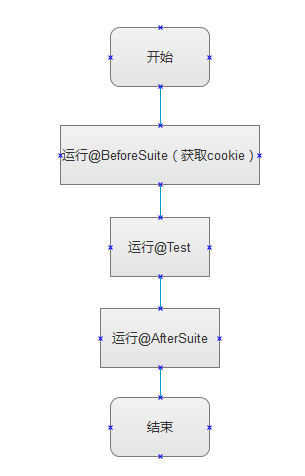5分钟教会你搭建接口自动化测试框架
🍅 视频学习:文末有免费的配套视频可观看
🍅?关注公众号【互联网杂货铺】,回复 1?,免费获取软件测试全套资料,资料在手,涨薪更快
一、原理及特点
- 参数放在XML文件中进行管理
- 用httpClient简单封装一个httpUtils工具类
- 测试用例管理使用了testNg管理,使用了TestNG参数化测试,通过xml文件来执行case。
- 测试报告这里用到第三方的包ReportNG 项目组织用Maven
二、准备
- 使用工具:eclipse,maven
- 用到的第三方jar包:dom4j、reportng、testng
- 理解难点:httpUtils和xmlUtil工具类的封装;dom4j使用;CookieStore的应用
三、框架构思
1、项目结构

2、用例执行流程

3、接口调用流程?

4、调度脚本流程

四、框架实现
1、输入参数
1.1 参数放在XML文件中进行管理
例:这里测试获取角色的接口输入参数为,page和rows,mapRole.xml内容如下
<?xml version="1.0" encoding="UTF-8"?>
<map>
<bean beanName="GetRole">
<!--Locator lists -->
<locator name="page" value="1"></locator>
<locator name="rows" value="10"></locator>
</bean>
</map>1.2 封装一个xmlUtil工具类负责读取XML,使用第三方的jar包dom4j
1.2.1 xmlUtil中readXMLDocument方法返回值为HashMap<String, String>
public static HashMap<String, String> readXMLDocument(String beanName,String xmlName){
}2、返回参数
2.1 创建一个接口返回对象ResponseBean
对象ResponseBean,包括status、statusCode、contentType、body、url、method、cookies
2.2 在工具类中在创建一个ReponseUtil工具类
ReponseUtil工具类负责将请求的返回数据CloseableHttpResponse 转换成ResponseBean
public ResponseBean setResponseBean(CloseableHttpResponse httpResponse) {
}3、测试用例
测试用例管理使用了TestNG管理 ,使用了TestNG参数化测试,通过xml文件来执行case
3.1 测试case脚本
public class GetRoleTest {
static CookieStore cookieStore ;
static CookieUtil cookieUtil=new CookieUtil() ;
CloseableHttpClient client;
HttpUtils httpUtils=HttpUtils.getInstance();
@Parameters({ "url", "objBean" ,"statusCode","xmlName"})
@BeforeSuite
/*
* 登录进入系统获取JSESSIONID放入到CookieStore中
* */
public void TestLoginIn(String url ,String objBean, String statusCode,String xmlName) {
Map<String,String> params=xmlUtil.readXMLDocument(objBean,xmlName);
client = HttpClients.createDefault();
CloseableHttpResponse httpResponse= httpUtils.post(url, params, client, cookieStore);
//cookieUtil.printResponse(httpResponse);
cookieStore=cookieUtil.setCookieStore(httpResponse);
}
@Parameters({ "url", "objBean" ,"statusCode","body","xmlName"})
@Test(priority = 2)
public void TestGetRole(String url ,String objBean, String statusCode,String body,String xmlName) {
Map<String,String> params=xmlUtil.readXMLDocument(objBean,xmlName);
client = HttpClients.custom().setDefaultCookieStore(cookieStore).build();
CloseableHttpResponse httpResponse= httpUtils.post(url, params, client, cookieStore);
ResponseBean rb=new ReponseUtil().setResponseBean(httpResponse);
// add Assert
Assert.assertEquals("OK", rb.getStatus());
Assert.assertEquals(statusCode, rb.getStatusCode());
Assert.assertEquals(true, rb.getBody().contains(body));
}
@AfterSuite
public void closeClient(){
try {
// 关闭流并释放资源
client.close();
} catch (IOException e) {
e.printStackTrace();
}
}
}[注] 因为API接口测试时每次都要校验Cookie,所有我们每次都先执行登录操作去获取Cookie
3.2 xml文件的编写
<?xml version="1.0" encoding="UTF-8"?>
<!DOCTYPE suite SYSTEM "http://testng.org/testng-1.0.dtd">
<suite name="TestGetRole" parallel="classes" thread-count="5">
<parameter name="url" value="/sys/login" />
<parameter name="objBean" value="loginIn" />
<parameter name="status" value="OK" />
<parameter name="statusCode" value="200" />
<parameter name="xmlName" value="mapRole" />
<test name="TestGetRole" preserve-order="true">
<parameter name="url" value="/json/getRoleInfo" />
<parameter name="objBean" value="GetRole" />
<parameter name="status" value="OK" />
<parameter name="statusCode" value="200" />
<parameter name="body" value="roleName" />
<classes>
<class name="com.lc.testScript.GetRoleTest">
<methods>
<include name="TestGetRole" />
<!--<include name="TestGetRole2" />-->
</methods>
</class>
</classes>
</test>
</suite>右键->run as ->TestNG Suite,这个场景的的测试用例就可以运行了
4、测试报告和项目组织
测试报告这里用到第三方的包ReportNG 项目组织用Maven
<project xmlns="http://maven.apache.org/POM/4.0.0" xmlns:xsi="http://www.w3.org/2001/XMLSchema-instance"
xsi:schemaLocation="http://maven.apache.org/POM/4.0.0 http://maven.apache.org/xsd/maven-4.0.0.xsd">
<modelVersion>4.0.0</modelVersion>
..........................................
..........................................
..........................................
<properties>
<project.build.sourceEncoding>UTF-8</project.build.sourceEncoding>
<xmlFileName1>TestGetRole.xml</xmlFileName>
.................这里写testNG对应的XML名称----------------------
<xmlFileName10>TestGetUser.xml</xmlFileName>
</properties>
<dependencies>
..........................
</dependencies>
<build>
<plugin>
<groupId>org.apache.maven.plugins</groupId>
<artifactId>maven-surefire-plugin</artifactId>
<version>2.19</version>
<configuration>
<suiteXmlFiles>
<suiteXmlFile>src/test/java/testSuites/${xmlFileName}</suiteXmlFile>
.................略............
..............这里的和properties中的xmlFileName想对应............
<suiteXmlFile>src/test/java/testSuites/${xmlFileName10}</suiteXmlFile>
</suiteXmlFiles>
</configuration>
</plugin>
<!-- 添加插件,添加ReportNg的监听器,修改最后的TestNg的报告 -->
<plugin>
<groupId>org.apache.maven.plugins</groupId>
<artifactId>maven-surefire-plugin</artifactId>
<version>2.5</version>
<configuration>
<properties>
<property>
<name>usedefaultlisteners</name>
<value>false</value>
</property>
<property>
<name>listener</name>
<value>org.uncommons.reportng.HTMLReporter</value>
</property>
</properties>
<workingDirectory>target/</workingDirectory>
</configuration>
</plugin>
<plugin>
<artifactId>maven-compiler-plugin</artifactId>
<version>3.5.1</version>
<configuration>
<source>1.8</source>
<target>1.8</target>
</configuration>
</plugin>
</plugins>
</build>
</project>[注] 因为是maven的项目所以要将testSuite的xml文件放在maven的test目录下,这样右键pom.xml文件maven test,所有的测试用例就开始执行了
测试报告

框架目前存在的不足
同时,在这我为大家准备了一份软件测试视频教程(含面试、接口、自动化、性能测试等),就在下方,需要的可以直接去观看,也可以直接【点击文末小卡片免费领取资料文档】
软件测试视频教程观看处:
【2024最新版】Python自动化测试15天从入门到精通,10个项目实战,允许白嫖。。。
本文来自互联网用户投稿,该文观点仅代表作者本人,不代表本站立场。本站仅提供信息存储空间服务,不拥有所有权,不承担相关法律责任。 如若内容造成侵权/违法违规/事实不符,请联系我的编程经验分享网邮箱:chenni525@qq.com进行投诉反馈,一经查实,立即删除!
- Python教程
- 深入理解 MySQL 中的 HAVING 关键字和聚合函数
- Qt之QChar编码(1)
- MyBatis入门基础篇
- 用Python脚本实现FFmpeg批量转换
- 认真学SQL——MySQL入门之表中约束——约束数据的插入和删除
- 【Unity的实现好用的曲面UI_切角曲面边框流光效果_案例分享(内附源码)】
- 大数据之力:从数据湖到数据智能的升级之路
- JAVA解决山脉数组的峰顶索引问题
- 『 C++ 』AVL树详解 ( 万字 )
- Python 课堂记录
- ROS学习笔记(七)---参数服务器
- IO进程线程Day3
- 【Python学习】Python学习19- 异常处理
- 适合通用隔离应用的MAX12930BASA、ADUM2280BRIZ、ADUM2286BRIZ、ADUM1280WARZ双通道数字隔离器